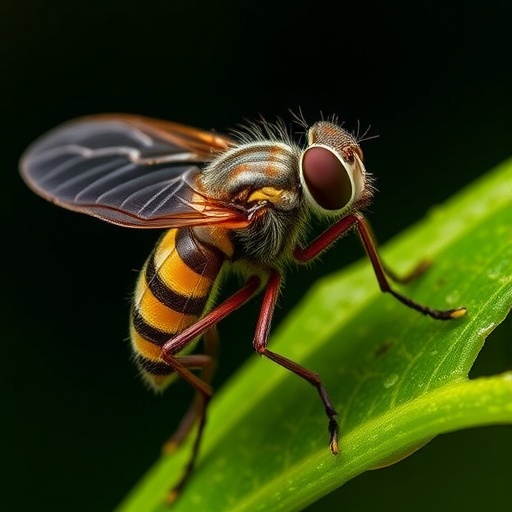In the intricate world of developmental biology, the phenomenon of metamorphosis represents one of the most remarkable feats of cellular cooperation and transformation. Fruit flies, scientifically known as Drosophila melanogaster, have long served as a quintessential model organism to decipher the biological choreography underlying these profound changes. Recent groundbreaking research spearheaded by teams at The University of Osaka, The University of Tokyo, Tohoku University, and Future University Hakodate has illuminated the critical role of cellular heterogeneity during metamorphosis, revealing how diverse cell types dynamically coordinate to remodel muscle tissue efficiently and precisely.
Metamorphosis demands the comprehensive breakdown of larval muscles to pave the way for adult musculature, a process orchestrated at the cellular level with exquisite complexity. Using cutting-edge real-time microscopy, researchers observed how sarcolytes—muscle fragments remaining from the larval stage—and hemocytes—immune cells responsible for engulfing and recycling debris—engage in a delicate dance to reshape the pupal tissue. The study specifically tackled a long-standing question: how do intrinsic differences within and between these cellular populations contribute to tissue remodeling during metamorphosis?
Employing sophisticated computational modeling alongside live imaging techniques, the researchers established a triadic interaction among sarcolytes, hemocytes, and a third pivotal player: fat body cells. Fat body cells, often overlooked in the context of muscle remodeling, emerged as key structural engineers, providing necessary spatial organization and mechanical support. The synergistic activity of these three populations enables an optimal environment for muscle degradation and reconstruction, ensuring that new cellular architecture emerges with both speed and accuracy.
A particularly striking finding from the study is the identification of variability—heterogeneity—in the behavior of hemocytes during their migratory and scavenging roles. Unlike uniform, homogenous behaviors previously assumed, hemocytes exhibited differential velocities and navigational patterns. Some cells moved linearly and rapidly, facilitating long-distance transfer of sarcolyte fragments, while others displayed meandering trajectories which contributed to local rearrangements and stabilization of the developing muscle framework. This behavioural diversity within a single cell type underscores a previously unappreciated layer of functional complexity critical for developmental success.
From a biophysical perspective, sarcolytes demonstrated an initial phase of rapid mobility, enhancing the dispersal of muscular debris across the pupal tissue. Over time, their motility decelerated, dovetailing with a transition to a more ordered spatial arrangement. This transition is believed to be essential for proper integration of muscle fragments into the emerging adult musculature. Fat body cells, in this context, act as an architectural scaffold, modulating intercellular spacing and effectively ‘corralling’ sarcolytes to achieve the desired structural outcome.
The integrative computational simulations developed by the team allowed for the interrogation of various parameters influencing cell dynamics. Simulations revealed that interactions purely between sarcolytes and hemocytes were insufficient for stable muscle remodeling. Only with the inclusion of fat body cells did the model recapitulate in vivo observations, reinforcing the necessity of a multi-cellular consortium characterized by diverse yet coordinated roles. This modeling approach provides a predictive framework for understanding how cellular heterogeneity engenders robustness in developmental processes.
The implications of this research reach beyond developmental biology, touching on the burgeoning field of biomimetic robotics. The study’s senior author, Dr. Takeshi Kano, posits that heterogeneous swarms of robots, designed to mimic the division of labor and variable behaviors observed in cellular populations, might outperform homogenous groups in complex task environments. This cross-disciplinary insight paves the way for innovations in swarm intelligence and adaptive engineering strategies, inspired directly by biological principles.
At a molecular level, the differential speeds and navigation strategies of hemocytes might be underpinned by varying expression levels of cytoskeletal components and signaling molecules, though further research is required to delineate these mechanisms. The study’s approach, combining live-cell microscopy with computational modeling, exemplifies the modern paradigm of systems biology, where dynamic behaviors cannot be fully understood without integrative methodologies.
The research stands as a testament to the notion that cellular heterogeneity is not a byproduct of biological noise but a functional attribute harnessed during development. The rapid redistribution of sarcolytes is complemented by their precise spatial placement, two ostensibly conflicting objectives harmonized through the interplay of diverse cellular actors. This dual-purpose dynamic expands our conceptual understanding of how biological systems negotiate competing demands in real time.
Moreover, the discovery opens avenues for exploring how similar principles operate in other metamorphic organisms or during tissue regeneration, potentially broadening the biomedical relevance. Understanding how heterogeneity influences cell behavior in developmental contexts might provide insights into pathological conditions where such coordination fails, such as in muscle degenerative diseases or impaired wound healing.
This pioneering study will be published in PLOS Computational Biology, marking a significant leap in developmental biology and computational modeling. As we continue to uncover the layers of complexity in biological systems, cellular heterogeneity emerges not merely as a biological curiosity but as a cornerstone of adaptive success in living organisms. The work epitomizes the synergy of empirical observation and computational simulation in unraveling the subtleties of life’s dynamic architecture.
Subject of Research: Cells
Article Title: Dual-purpose dynamics emerge from a heterogeneous cell population in Drosophila metamorphosis
News Publication Date: 28-Aug-2025
Web References: http://dx.doi.org/10.1371/journal.pcbi.1013331
Image Credits: D Wakita, S Yamaji, D Umetsu and T Kano (2025)
Keywords: Developmental biology, Insects, Muscles, Muscle cells, Muscle tissue, Pupae, Cell behavior




